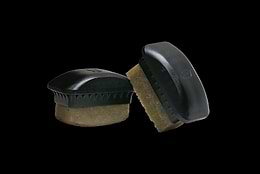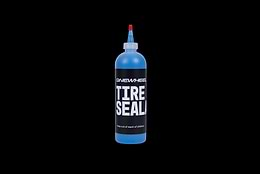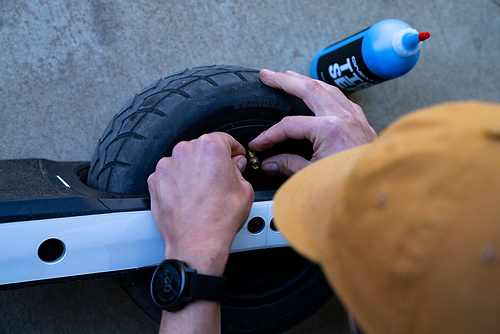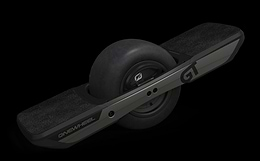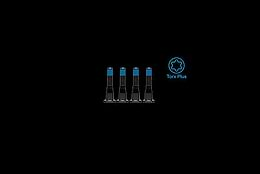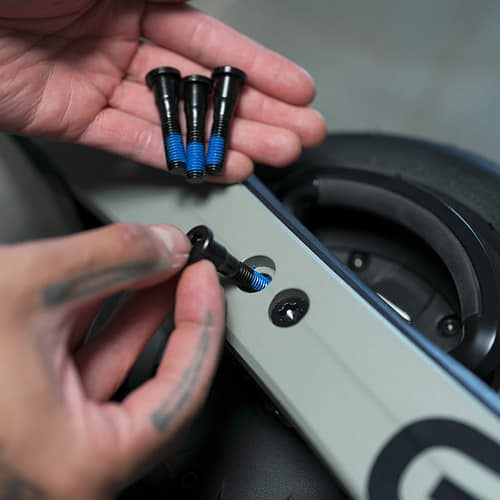Onewheels are known for their build quality and durability. We like to say they’re built like a tank and, it’s true, they can handle a beating. We meticulously assemble each board in our San Jose, California factory which has driven us to lead the industry in manufacturing and quality control practices. This translates to real-world dependability. Most riders get thousands of miles out of their boards. We've chronicled stories of rides from Canada to Mexico, from the East Coast to the West Coast and other epic trips that can be too much for even some cars.
Unlike a bike with chains or gears, Onewheels use a brushless hub motor which means you don’t have to grease anything up to keep it running smoothly. Unlike a car, you never have to change your oil. Because of their brilliantly simple design, Onewheels are one of the easiest vehicles to maintain; by and large, you just need to plug them in to charge.
While Onewheels are designed to ride thousands of miles, you'll need to do some board maintenance, just like any vehicle. In this post, we'll cover some essential tips to keep your Onewheel in great shape. Let’s get started.
Worn Footpads
The footpads on your Onewheel can become dirty and worn over time, especially if you’re riding off-road or without a fender. To keep them in good condition, use a grip tape eraser to clean the surface. This will remove dirt and restore the grip of the footpads.
If your footpads are severely worn or damaged, you may need to replace them. You’ll know it’s time when you no longer have adequate traction from your grip tape. A fresh set of footpads is the easiest way to refresh the look and feel of your board. We sell multiple different types of footpads on our site. It’s incredibly easy to replace the footpads. Simply remove the existing footpads with the allen wrench provided in your new set and then screw in your fresh pads.
That Big Tire
The tire is your only point of contact with the ground, so it’s imperative to make sure that your tire is maintained properly. We recommend keeping your tire pressure between 15psi and 20psi. Running lower tire pressure than recommended will accelerate the rate at which your tire wears down. Running higher tire pressure will affect the riding dynamics of the tire.
If your tire is losing air consistently, you may have a slow leak. In this instance, you will need to add our specially formulated and nontoxic, tire sealant designed specifically for Onewheel tires. The tire sealant also helps to prevent flats and punctures. Every new Onewheel arrives with fresh tire sealant already inside the tire. Once you’ve ridden your Onewheel a fair amount, or at least every 6 months, it's a good idea to add tire sealant.
It's important to keep an eye on the tire's wear and tear. Over time, the tire can become worn down or damaged, which can affect the performance of the board. Most commonly, this occurs when the edge of the tire wears through and you begin to see the threading beneath the tire's original surface. If you notice any signs of wear or damage, replace the tire as soon as possible. Tire Replacements require disassembling the board. We offer Tire Replacements as a service or, if you'd like to replace it yourself, you can choose to order a Tire by itself.
No Loose Screws
We apply Loctite to secure our screws and have exact torque specs at our factory to ensure industry-leading dependability. If you’re not opening up your board, these screws should remain tight for the lifetime of your board. If you're riding aggressively or over intense terrain, the vibrations over time can cause the screws to loosen in some situations. After riding your Onewheel for ~500 miles, we recommend checking the screws and tightening them if necessary. If they're worn out, you can also replace the screws.
Cleaning Your Fender
The fender on your Onewheel can become dirty and clogged over time. To clean it, you'll need to remove the fender and wash it separately. Use a soft brush and mild soap to clean the fender, and then let it dry before screwing it back onto your board. Having a fender is also a really helpful way to avoid wear and tear on your footpads.


Did Your Board Get Wet?
Onewheels are water-resistant, not waterproof. They can withstand some moisture, but we recommend taking extra caution when riding in damp areas or near water. We'll outline a few tips to keep your board in healthy condition after getting wet. First off, dry your board completely before charging to avoid damage. This means hand drying it with a towel, then air drying it with the tire on the ground on the tire (not standing it up vertically). If you stand the board up, water can seep into the bearings and damage them. If you’ve ridden your board at the beach, through puddles, or on muddy trails, you’ll probably notice dirt and grime build up. It's important to clean your board every time after these types of rides. Use a cloth and mild soap to gently scrub the board and remove any debris. If getting your board wet feels unavoidable in your city, make sure that you’ve installed a charger plug!
Riding in Cold Weather
If you live in a cold climate, make sure to bring your board inside when you’re done riding. Long exposure to extremely cold temperatures can adversely affect your board’s battery health. For long term storage, make sure to charge your board between 40-50% and store it in a dry place that's between 50℉ - 60℉ (10℃ - 15℃). Check monthly to ensure your battery remains between 40-50%. Once it’s riding season, give your board a full inspection before riding again.
Maintaining your Onewheel is essential for keeping it in excellent condition and ensuring its longevity. By following these maintenance tips, you can keep your board running smoothly and safely for years to come.


